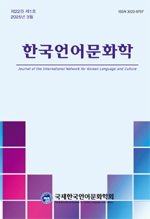한국어 학습자의 용언 활용 발달 양상
Developmental Patterns of Verb and Adjective Inflection in Korean Language Learners
- 국제한국언어문화학회
- 한국언어문화학
- 제22권 제1호
-
2025.03287 - 312 (26 pages)
-
DOI : 10.15652/ink.2025.22.1.287
- 29

이 연구는 용언의 형태소 결합 구조 유형을 분석하여 한국어 학습자의 용언 활용 발달 양상을 고찰하였다. 특히, 결합 구조 유형의 출현 빈도가 아니라 사용 학습자 수를 중심으로 분석함으로써 보편적인 발달 양상을 살펴보고자 하였으며, 이를 위해 한국어 학습자 문어 말뭉치 1,686,802어절을 대상으로 용언에 결합한 형태소 구조 유형을 추출하여 분석하였다. 분석 결과, 학습자 모어에 상관 없이 4급부터 75%의 학습자가 사용하는 고정적인 유형이 7개 있었고, 이 중 용언에 연결어미 및 관형사형 전성어미가 결합한 구조는 3급부터 90% 이상의 학습자들이 사용하는 것으로 나타났다. 또한 비종결어미의 결합 구조에서 학습자 모어 집단 간 차이가 나타났는데, 일본어 모어 학습자들이 중국어 모어 학습자보다 다양한 유형을 사용하고 동일한 유형의 경우에도 더 먼저, 더 많은 학습자들이 사용하였다. 특히 선어말어미와 비종결어미가 결합하거나 보조용언과 비종결어미가 결합하는 구조는 중국어 모어 학습자들의 사용 비율이 낮게 나타났다. 이와 같은 연구 결과를 통해 보편적으로 습득이 되는 용언의 형태소 결합 구조를 확인할 수 있었고, 용언의 활용 발달에 미치는 학습자 모어의 영향도 알 수 있었다.
Journal of the International Network for Korean Language and Culture 22-1, 287-312. This study analyzes the morphological combination patterns of verb and adjective inflection to examine the developmental aspects of inflectional usage among Korean language learners. Rather than focusing on the frequency of occurrence of combination patterns, this study forces on the number of learners using each pattern to investigate universal developmental trends. To achieve this, a corpus of 1,686,802 written word tokens produced by Korean language learners was analyzed. The analysis revealed that, regardless of the learners' native language, seven fixed patterns were employed by 75% of learners from Level 4 onwards. Among these, the structure combining verb endings with connective endings and attributive-formative endings was used by over 90% of learners from Level 3 onwards. Furthermore, differences were observed among native language groups in the combination of non-final endings. Japanese native language learners employed a wider variety of patterns compared to Chinese native language learners, and even when using the same patterns, Japanese learners did so more frequently and at an earlier stage.(The Academy of Korean Studies, Konkuk University)
1. 서론
2. 연구 방법
3. 연구 결과
4. 논의
5. 결론
참고문헌
(0)
(0)